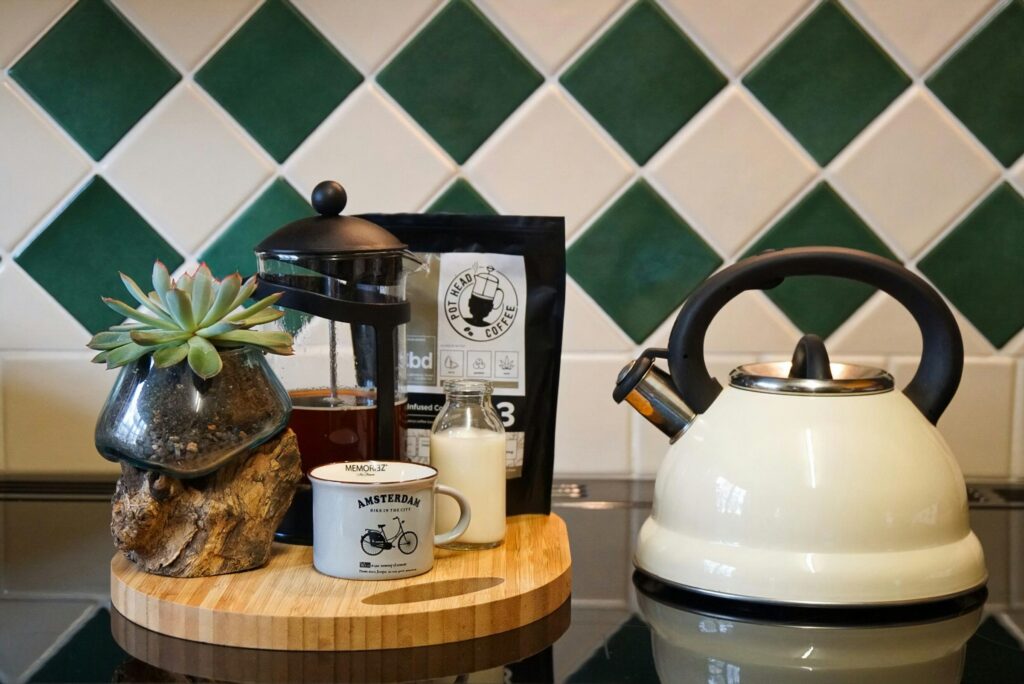There’s something almost magical about a French press. No fancy machines, no complicated gadgets—just you, hot water, and freshly ground beans.
When brewed correctly, it rewards you with a cup that’s bold, smooth, and full of character.
The best part? Mastering it doesn’t take years of practice or barista training.
With a few simple steps, you can unlock café-quality coffee right at home.
This guide will walk you through everything you need to know so your next cup tastes as good as it smells!
What Makes French Press Coffee Special
Full Immersion Brewing = Richer Extraction
Unlike drip machines that let water pass through the grounds too quickly, the French press lets coffee and water mingle for several minutes. Every bit of flavor has time to dissolve into the brew.
This slower, deeper process pulls out the natural sweetness, the subtle notes, and yes—even that satisfying bold punch. Think of it as steeping tea, but with beans instead of leaves.
No Paper Filters = Natural Oils and Fuller Body
Paper filters are great for clarity, but they also steal away the flavorful oils that give coffee its depth. A French press uses a fine metal mesh, which allows those oils to flow right into your cup.
The result? A coffee that feels heavier, richer, and more “whole.” It’s the difference between sipping light broth and diving into hearty stew.
Once you taste that fullness, going back to paper-filtered coffee feels like missing half the story.
A Hands-On, Ritual-Like Process
There’s something grounding about the French press. You measure the beans, grind them just right, pour in the water, and wait. No buttons. No blinking screens. Just you and the process.
For many people, it’s less about the caffeine and more about the ritual—a few calm minutes before the day begins.
It’s simple, it’s personal, and when you finally press down that plunger, it feels like you’ve earned that cup.
Tools & Ingredients You’ll Need
Before you dive in, make sure you’ve got the right gear on the counter.
A French press doesn’t need much, but the details matter. Here’s the lineup:
- French Press
- Common sizes:
- 3-cup (12 oz / ~350 ml) – perfect for one.
- 8-cup (34 oz / ~1 liter) – ideal for two or three.
- 12-cup (51 oz / ~1.5 liters) – great for a crowd.
- Common sizes:
- Freshly Roasted Coffee Beans
- Measure about 1 gram of coffee for every 15–17 grams of water.
- Example: For an 8-cup French press (34 oz / 1 liter water), you’ll need 60–67 grams of coffee (roughly 8–10 tablespoons whole beans).
- Burr Grinder
- Essential for a consistent coarse grind—think sea salt, not sand.
- Blade grinders create uneven particles, which mess with flavor.
- Kettle
- Any kettle works, but a gooseneck gives better control when pouring.
- Heat water to about 200°F (93°C)—just off the boil.
- Digital Scale
- Accuracy makes a huge difference.
- No more guessing—get repeatable results every time.
- Timer
- Steep time is usually 4 minutes.
- A kitchen timer or your phone does the trick.
- Fresh, Filtered Water
- Coffee is 98% water, so quality counts.
- Use about 500 ml (17 oz) of water for 30–33 g of coffee.
Step-by-Step Brewing Guide
Step 1: Measure & Grind
Start by weighing your coffee. A good starting point is 1 gram of coffee for every 15–17 grams of water. For example, an 8-cup French press (about 34 oz / 1 liter) uses 60–67 grams of coffee.
Grind it coarsely—think sea salt, not table salt. This prevents grit in your cup and stops over-extraction.
Step 2: Heat the Water
Bring your water just to a boil, then let it sit for about 30 seconds. You’re aiming for ~200°F (93°C).
Too hot and you’ll scorch the grounds; too cool and your coffee will taste flat. Use filtered water for the cleanest flavor.
Step 3: Add Coffee Grounds
Add the ground coffee to the empty French press. Spread it out evenly so water hits all the grounds at once. This small step helps you get a balanced extraction every time.
Step 4: Bloom
Pour just enough hot water to cover the grounds. Stir gently to make sure everything is wet, then let it sit for about 30 seconds.
This “bloom” releases trapped gases and makes your final brew taste sweeter and smoother.
Step 5: Fill & Stir
Pour in the rest of your hot water slowly. Stir once or twice to break up the floating crust of grounds. This ensures even contact between water and coffee.
Step 6: Steep
Place the lid on with the plunger pulled all the way up. Let it steep for 4 minutes without touching it.
This is where the magic happens—the full-immersion brew draws out all those bold, rich flavors.
Step 7: Plunge Slowly
When time’s up, press the plunger down slowly and steadily. Don’t rush it or force it. A smooth press keeps the grounds at the bottom and avoids sending grit into your cup.
Step 8: Pour Immediately
As soon as you’ve plunged, pour your coffee into mugs or a serving carafe. Leaving it in the French press causes over-extraction, which leads to bitterness. Enjoy!
Pro Tips for the Perfect Cup
Preheat Your French Press
Before you even add your coffee, pour some hot water into the French press and give it a quick swirl. This keeps the glass warm and prevents your brew from losing heat too quickly.
Think of it like warming up your car on a cold morning—it makes everything run smoother. Dump that water out before you add your grounds.
Experiment with Brew Time
Four minutes is the sweet spot for most people, but don’t treat it like an unbreakable rule.
Want a brighter, lighter cup? Try 3 minutes. Craving something bolder and heavier? Let it go for 5 minutes.
Everyone’s taste buds are different, so treat brew time as your personal dial for flavor.
Stirring vs. Not Stirring
Here’s where coffee geeks split camps. Stirring after you add the water helps mix the grounds evenly, leading to a richer, fuller taste.
But skipping the stir lets the grounds settle, which gives you a cleaner, less sludgy cup.
There’s no right or wrong here—just two different styles. Try both and see which one makes your taste buds sing.
Decant Into Another Vessel
Once you’ve plunged, don’t let the coffee sit in the press. It will keep extracting and eventually turn bitter.
If you’re not drinking it all right away, pour the coffee into a separate carafe or thermos.
Common Mistakes to Avoid
Grinding Too Fine
One of the biggest rookie mistakes is grinding your coffee too fine. A fine grind clogs the filter, slips into your cup, and leaves you sipping muddy sludge.
It also over-extracts, which gives you that sharp, bitter edge nobody wants first thing in the morning. Stick to a coarse grind—about the size of sea salt—for a smooth, clean brew.
Letting Coffee Sit in the Press Too Long
Once your coffee is brewed and plunged, the clock starts ticking. If you leave it sitting in the press, the grounds keep brewing, and the flavor gets harsher by the minute.
What started as rich and bold can quickly turn into something sour and astringent.
If you’re not drinking it all right away, pour it into a carafe or thermos to save your taste buds from disappointment.
Using Stale Beans or Tap Water
Great coffee starts with great ingredients. If your beans are months old or you’re using flat-tasting tap water, no brewing method can save you.
Freshly roasted beans bring out the aroma and flavor you’re chasing.
Filtered water keeps things clean and crisp.
Rushing the Plunge
The plunge is the grand finale, so don’t rush it. Shoving the plunger down too fast can stir up the grounds and send grit floating back into your cup.
Worse, it can crack your glass press if you’re too forceful. Take it slow and steady—gentle pressure makes for a smoother drink and a happier morning.
Variations & Advanced Techniques
Cold Brew in a French Press
Your French press isn’t just for hot coffee. It makes fantastic cold brew too. Add coarsely ground coffee to cold water using about a 1:8 ratio (coffee to water).
Stir it, cover it, and let it sit in the fridge for 12–16 hours. When it’s ready, press down the plunger slowly and enjoy a smooth, low-acid brew that’s perfect over ice.
It’s a lifesaver on sweltering mornings when hot coffee feels like punishment.
Double Filtering for Clarity
If you prefer a cleaner cup, try double filtering. After plunging, pour your coffee through a paper filter or a fine mesh sieve into another carafe.
This catches the tiny particles that sneak through the French press filter. The result is a cup with less “mud” at the bottom and a silkier mouthfeel.
Some people swear by it, others love the extra body of unfiltered—either way, it’s worth testing once.
Adjusting Ratios for Stronger/Weaker Brews
The “perfect” ratio is personal. Standard French press brewing uses around 1:15–1:17 (coffee to water). If you want a punch-in-the-face strong brew, edge closer to 1:12.
If you like something gentler, stretch it to 1:18 or beyond. Play around until you hit your sweet spot. Coffee is flexible, and it should fit your taste, not the other way around.
Flavor Add-Ins: Cinnamon, Vanilla, or Cardamom
Sometimes, a little twist makes your cup unforgettable. Toss in a cinnamon stick with your grounds for a warm, cozy spice. Add a few drops of vanilla extract for sweetness without sugar.
Or sprinkle in crushed cardamom pods for a Middle Eastern flair. These add-ins brew alongside the coffee, infusing flavor directly into the cup.
Just keep it subtle because too much and you’ll drown out the coffee itself.
Final Words
The French press proves that simple gear can deliver huge flavor. No buttons, no fuss—just bold, satisfying coffee every time.
With a few small tweaks, anyone can master the process. Grind right, time it well, and let the ritual do the rest.
So grab your press, heat some water, and give it a try today. Your richest, most rewarding cup is just one plunge away!
FAQs
Can I use pre-ground coffee in a French press?
Yes, but it’s not ideal. Most pre-ground coffee is too fine, which can leave you with sludge and bitterness. If it’s your only option, go for it—but freshly ground beans will always taste better.
How do I clean my French press properly?
After brewing, dump the grounds (compost them if you can), then rinse the carafe with warm water. Take apart the plunger occasionally to scrub the mesh filter and gasket.
A little baking soda works wonders for stubborn stains and lingering oils.
What’s the best grind size for a French press?
Coarse grind, about the texture of sea salt. Too fine, and you’ll end up with mud at the bottom of your cup. Too coarse, and your coffee will taste weak and watery.
How much coffee should I use per person?
A good rule of thumb is 1 tablespoon (7–8 g) of coffee per 4 oz (120 ml) of water. Adjust to taste, but this ratio keeps things balanced for most people.
Can I make tea in a French press?
Absolutely! Loose-leaf tea works beautifully. Just steep it as you normally would, then plunge slowly. It’s a quick, mess-free way to brew more than one cup at a time.
How to Brew the Perfect French Press Coffee
Course: Brewing GuidesCuisine: FrenchDifficulty: Beginner2-3
cups2
minutes4
minutes6
minutesBrew rich, bold coffee at home with this step-by-step French press guide. Learn the right grind, ratios, tips, and tricks for a perfect cup.
Ingredients
60 g coarsely ground coffee (about 8 tablespoons)
1 liter (34 oz) filtered water, heated to ~200°F (93°C)
Directions
- Preheat your French press with hot water, then discard the rinse.
- Add the coffee grounds to the carafe.
- Pour in a small amount of hot water to cover the grounds. Stir gently and let it bloom for 30 seconds.
- Add the remaining hot water, stir once to break the crust, and place the lid on with the plunger pulled up.
- Steep for 4 minutes without touching it.
- Press the plunger down slowly and evenly.
- Pour immediately into mugs or a carafe to prevent over-extraction.
- Enjoy a rich, bold cup of coffee straight from your press.
Notes
- Use fresh beans roasted within the last 2–3 weeks for the best flavor.
- Grind just before brewing to keep the aromas intact.
- Swirl the press gently before plunging for a more even extraction.
- Don’t skip the preheat—a warm press keeps your brew consistent.
- Experiment with ratios until you find your personal “sweet spot.”



